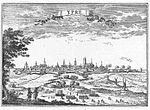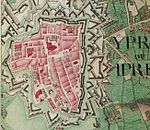Bard Cottage Cemetery
Cemeteries and memorials in West FlandersCommonwealth War Graves Commission cemeteries in BelgiumWorld War I cemeteries in Belgium

Bard Cottage Cemetery is a World War I, Commonwealth War Graves Commission burial ground near Ypres, Belgium. It is home to 1607 identified casualties. The cemetery is half a kilometre north of Essex Farm Cemetery.
Excerpt from the Wikipedia article Bard Cottage Cemetery (License: CC BY-SA 3.0, Authors, Images).Bard Cottage Cemetery
Diksmuidseweg,
Geographical coordinates (GPS) Address Nearby Places Show on map
Geographical coordinates (GPS)
| Latitude | Longitude |
|---|---|
| N 50.8764 ° | E 2.8685 ° |
Address
Diksmuidseweg 156
8900 , Boezinge
West Flanders, Belgium
Open on Google Maps









